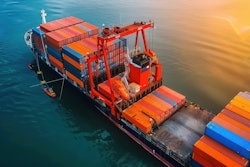
In today’s changing climate, natural disasters and extreme weather events are growing more common. According to the Intergovernmental Panel on Climate Change’s Sixth Assessment Report, the human-caused rise in greenhouse gases has increased both the prevalence and intensity of extreme weather events across the globe. From hurricanes and wildfires to winter storms and extreme heat, these disruptions significantly impact supply chains, causing delays, increased costs and operational inefficiencies.
To mitigate these challenges—and adjust to our new weather reality—organizations must integrate advanced weather modeling into their transportation management system (TMS) strategies, leveraging predictive climate models, hyperlocal forecasts, and decision-support tools to build resilience and maintain efficiency.
The growing impact of extreme weather
According to the National Oceanic and Atmospheric Administration, the United States experienced 28 separate billion-dollar weather and climate disasters in 2023 alone, setting a record for frequency and economic toll. The financial impact of these events on supply chains is staggering, with lost revenue, damaged goods, and increased transportation costs straining operations.
Extreme weather can affect logistics in several ways. Delays and route disruptions caused by flooded roads, closed ports, and impassable highways force rerouting, leading to costly delays.
For example, earlier this year a deep freeze in the South shuttered ports for days. The economic trickle-down effect of these changes to existing routes and plans, can increase costs from higher fuel consumption, overtime labor, and last-minute alternative transportation from any disruptions. Additionally, inventory shortages may result from interruptions in freight movement, delaying replenishments and causing stockouts that leave customers dissatisfied.
Safety risks also escalate as poor weather conditions increase the likelihood of accidents, posing risks to both drivers and cargo. Given these challenges, relying on historical weather patterns alone is no longer sufficient. Organizations need a proactive, data-driven approach that integrates real-time weather intelligence into supply chain operations.
The role of advanced weather modeling in TMS
Traditional TMS platforms focus on optimizing routes, managing freight, and improving operational efficiency. However, without advanced weather modeling, they lack the ability to anticipate disruptions and respond proactively. Integrating weather intelligence into a TMS enhances decision-making by providing actionable insights into how weather events will impact supply chain operations.
Predictive climate models use historical and real-time meteorological data, in addition to other data inputs, such as topography and route maintenance to forecast potential disruptions weeks in advance. These models help businesses anticipate seasonal risks—such as hurricanes or winter storms—allowing for strategic inventory planning. They also enable companies to adjust long-term logistics strategies based on climate trends, reducing vulnerability to disruptions.
Optimizing supplier and distribution center locations based on climate risk further enhances resilience. While broad climate models provide strategic insights, granular forecasts enable real-time operational adjustments. These detailed forecasts offer weather predictions specific to key transit routes, warehouses, and delivery zones. They can provide alerts on sudden weather shifts, enabling proactive decision-making and supporting on-time commitments.
For example, one U.S. trucking company relied on tailored forecasts and advisories for their specific routes during a winter storm in 2023 that spanned 10 states. The company created a comprehensive operational plan days before the event that accounted for each day the storm was active. Consistent weather communication informed drivers at key periods directing them to clear areas and safe places to park if conditions became difficult. Due to advanced weather intelligence integrated into the operational decision-making, the company reported that they kept their delivery commitments with adequate time to prepare.
Weather intelligence also improves driver safety by identifying hazardous conditions and suggesting alternative routes ahead of time, giving the option to choose a safer route. For instance, logistics teams leveraging hyperlocal weather intelligence can dynamically reroute shipments ahead of severe storms or strong winds reducing downtime and preserving service reliability.
Advanced decision-support tools integrate weather data with other operational metrics to provide real-time, automated recommendations. These tools enable dynamic route optimization by adjusting delivery schedules and paths in response to developing weather conditions. They support risk mitigation strategies by automating contingency plans, such as shifting shipments to alternative carriers or modes of transport. Enhanced visibility and collaboration across the supply chain improve coordination with partners and customers by sharing weather-impact insights.
The financial and logistical benefits of weather-aware TMS
Organizations that incorporate weather modeling into their TMS outlook can expect several key benefits.
Reduced downtime is achieved through early weather warnings that allow for proactive scheduling and/or rescheduling, minimizing costly delays. According to the U.S. Department of Transportation, more than 32 billion vehicle hours are lost each year due to weather congestion costing $3.4 billion annually.
Companies can achieve lower operational costs as a result of optimized routing and strategic inventory management that reduce fuel and labor expenses. Businesses can also achieve improved customer satisfaction from accurate delivery timelines and fewer disruptions, leading to better service reliability. Additionally, enhanced risk management helps companies avoid liability issues associated with hazardous driving conditions or damaged shipments.
Best practices for implementing weather intelligence
For organizations looking to enhance their TMS outlook with weather modeling, several best practices can help maximize its effectiveness.
Integrating real-time weather data enables businesses to utilize advanced weather intelligence providers that offer seamless integration with their current TMS platforms. Leveraging AI and machine learning enhances predictive capabilities and automates responses to weather disruptions, all from platforms that businesses are already comfortable with. By collaborating across the supply chain, operators can ensure stakeholders—from logistics teams to suppliers—have access to weather intelligence for coordinated responses. Investing in driver and staff training also equips employees with the knowledge to use weather-driven decision tools effectively, leading to better business outcomes.
The weather outlook
As extreme weather events become increasingly disruptive, businesses must adopt smarter, data-driven approaches to supply chain management. By integrating advanced weather modeling into their TMS outlook, organizations can improve resilience, optimize logistics, and safeguard profitability.
In an era where climate volatility is the new normal, leveraging predictive climate models, hyperlocal forecasts, and decision-support tools is not just a competitive advantage—it’s a necessity.




















